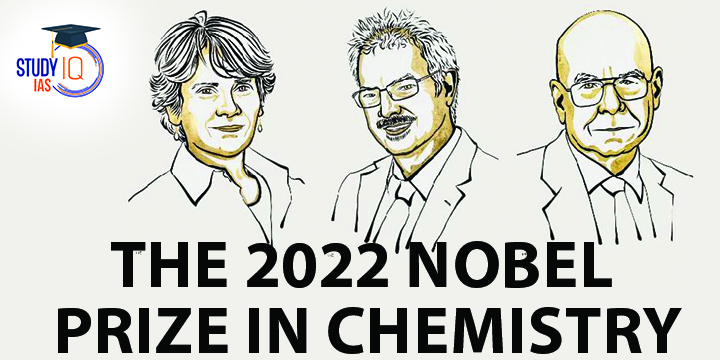Table of Contents
Nobel Prize in Chemistry: Background
- Ever since the birth of modern chemistry in the eighteenth century, many chemists have used nature as their role model for creating complex molecules especially for pharmaceutical research.
- However, one challenging problem is that complex molecules are built in many steps, with each step creating unwanted by-products, making the process time consuming and very expensive to produce.
- The Nobel Prize in Chemistry 2022 is all about finding new chemical ideals and letting simplicity and functionality take precedence.

Nobel Prize in Chemistry: Major Highlights of their Research
- The work of Barry Sharpless: He coined the concept of click chemistry, which is a form of simple and reliable chemistry, where reactions occur quickly, and unwanted by-products are avoided.
- The work of Morten Meldal: He along with Barry Sharpless – independent of each other – discovered a reaction known as the crown jewel of click chemistry: the copper catalyzed azide-alkyne cycloaddition (CuAAC).
- This is an efficient and straightforward chemical reaction. It is now in widespread use.
- Among many other uses, it is utilized in the development of pharmaceuticals, for mapping DNA and creating materials that are more fit for purpose.
- The work of Carolyn Bertozzi: She took the click chemistry to a whole new level by developing click reactions that work inside living organisms without disrupting the normal chemistry of the cell – what are now known as bio-orthogonal reactions.
- The problem with the CuAAC reaction is that copper is toxic to living beings. To solve this, in 2004, Carolyn discovered the copper-free click reaction, called the strain-promoted alkyne-azide cycloaddition (SPAAC).
- Bioorthogonal reactions are now used globally to explore cells and track biological processes.
- Using these reactions, researchers have improved the targeting of cancer pharmaceuticals, which are now being tested in clinical trials.
Nobel Prize in Chemistry: What is Click Chemistry?
- Click chemistry refers to a collection of organic reactions that proceed rapidly and selectively under mild conditions to covalently link molecular components.
- Click reaction uses only readily available reagents and is insensitive to oxygen and water. This aspect makes it widely acceptable.
- Applications of Click Chemistry:
- Drug discovery: Click chemistry has found increasing applications in all aspects of drug discovery in medicinal chemistry, such as for generating lead compounds through combinatorial methods.
- Bioconjugation: Click chemistry is rigorously employed in proteomics and nucleic research via bioconjugation.
- Radiochemistry: In radiochemistry, selective radiolabeling of biomolecules in cells and living organisms for imaging and therapy has been realized by click reactions.
- Nanoparticle modification: Click chemistry is generally used to conjugate the ligands, folate groups to the nanoparticles, which are then used for nanoparticle drug delivery.

Nobel Prize in Chemistry: What is Bioconjugation?
Bioconjugation is a chemical technique used to couple two molecules together, at least one of which is a biomolecule, such as a carbohydrate, nucleic acid, or protein.
Nobel Prize in Chemistry: What is Bioorthogonal Chemistry?
- The term bioorthogonal chemistry refers to any chemical reaction that can occur inside of living systems without interfering with native biochemical processes.
- Since its introduction, the concept of the bioorthogonal reaction has enabled the study of biomolecules such as glycans, proteins, and lipids in real time in living systems without cellular toxicity.
- Applications of Bioorthogonal Chemistry:
- Biological imaging: Bioorthogonal reactions are widely used for the understanding of the structures and functions of biomolecules such as proteins, lipids, and glycans etc.
- Targeted drug delivery: Bioorthogonal reactions are used for the site-specific delivery of antitumor agents.
- Vivo imaging: It is the non-invasive visualization of living organisms for research or diagnostic purposes.


 UPPSC Previous Year Question Papers, Dow...
UPPSC Previous Year Question Papers, Dow...
 Most Commonly Used Cancer Drugs and Thei...
Most Commonly Used Cancer Drugs and Thei...
 Tansen Biography, Musical Legacy and Mas...
Tansen Biography, Musical Legacy and Mas...





















